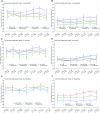Quality of Meals Consumed by US Adults at Full-Service and Fast-Food Restaurants, 2003-2016: Persistent Low Quality and Widening Disparities
- PMID: 31995199
- PMCID: PMC7443735
- DOI: 10.1093/jn/nxz299
Quality of Meals Consumed by US Adults at Full-Service and Fast-Food Restaurants, 2003-2016: Persistent Low Quality and Widening Disparities
Abstract
Background: Meals from full-service restaurants (FS) and fast-food restaurants (FF) are an integral part of US diets, but current levels and trends in consumption, healthfulness, and related sociodemographic disparities are not well characterized.
Objectives: We aimed to assess patterns and nutritional quality (using validated American Heart Association [AHA] diet scores) of FS and FF meals consumed by US adults.
Methods: Serial cross-sectional investigation utilizing 24-h dietary recalls in survey-weighted, nationally representative samples of 35,015 adults aged ≥20 y from 7 NHANES cycles, 2003-2016.
Results: Between 2003 and 2016, American adults consumed ∼21 percent of energyfrom restaurants (FS: 8.5% in 2003-2004, 9.5% in 2015-2016, P-trend = 0.38; FF: 10.5%; 13.4%, P-trend = 0.31). Over this period, more FF meals were eaten for breakfast (from 4.4% to 7.6% of all breakfasts, P-trend <0.001), with no changes for lunch (15.2% to 15.3%) or dinner (14.6% to 14.4%). In 2015-2016, diet quality of both FS and FF were low, with mean AHA diet scores of 31.6 and 27.6 (out of 80). Between 2003 and 2016, diet quality of FF meals improved slightly, (the percentage with poor quality went from 74.6% to 69.8%; and with intermediate quality, from 25.4% to 30.2%; P-trend <0.001 each). Proportions of FS meals of poor (∼50%) and intermediate (∼50%) quality were stable over time, with <0.1% of consumed FS or FF meals meeting ideal quality. Disparities in FS meal quality persisted by race/ethnicity, obesity status, and education and worsened by income; whereas disparities in FF meal quality persisted by age, sex, and obesity status and worsened by race/ethnicity, education, and income.
Conclusions: Between 2003 and 2016, FF and FS meals provided 1 in 5 calories for US adults. Modest improvements occurred in nutritional quality of FF, but not FS, meals consumed, and the average quality for both remained low with persistent or widening disparities. These findings highlight the need for strategies to improve the nutritional quality of US restaurant meals.
Keywords: American adults; NHANES; diet quality; fast-food restaurant meals; full-service restaurant meals; trends.
Copyright © The Author(s) 2020.
Figures


References
-
- Lin B-H, Guthrie JF.. Nutritional quality of food Prepared at home and away from home, 1977–2008 Washington (DC): U.S. Department of Agriculture, Economic Research Service; 2012.
-
- The Keystone Center The Keystone forum on away-from-home foods: opportunities for preventing weight gain and obesity. [Internet]. Retrieved November. 2006 May;11:2009 Available from:https://www.keystone.org/wp-content/uploads/2015/08/053006-Report-on-Key...
-
- United States Department of Agriculture Economic Research Service. [Internet]. Available from: https://www.ers.usda.gov/data-products/food-expenditures.aspx. [Accessed 2017 May1].

